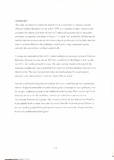| dc.contributor.author | Ngure, James K | |
| dc.date.accessioned | 2013-06-07T08:05:14Z | |
| dc.date.issued | 2001-05 | |
| dc.identifier.citation | Degree of Master of Medicine in Obstetrics and Gynaecology | en |
| dc.identifier.uri | http://erepository.uonbi.ac.ke:8080/xmlui/handle/11295/29799 | |
| dc.description | Thesis submitted for examination of Masters Of
Medicine
In
Obstetrics and Gynaecology
Of the
University Of Nairobi (Kenya | en |
| dc.description.abstract | The study was done to evaluate the bene fit 0 l a new proccd ure 0 f caesercan section
(Misgav l.adach) introduced in our unit in 1998, by comparing its intra- operative and
postopcrati ve outcomes to those 0f rout ine (traditional) caesercan section procedure
performed in majority olhospitals in Kenya, This study was justified by the fact that the
number and rate or caeserean section is increasing in our hospitals yet facilities and time
remain constant. Moreover the techniques used in performing a caeserean section
currently have never been validated scientifically,
;\ prospect: vc random ized trial 0 I' 2 14 women undergo ing cacscrean sect ion at Purnwan i
Maternity Hospital was carried out: 107 were randomized to the Misgav l.adach group
and 107 to the trad i t ional method grou p. The pri nc ipa I investigator performed all the
cacsercan sections over one year peri od. Intra-opcrat ive and postopcraii ve outcomes were
then recorded, The data was analyzed using statistical package for social sciences
(spss/pc+), chi-squire student's t-test and Manu-Whitney u test.
Operating and hospital stay time for patients in the new method group was significantly
shorter. Surgical consumablcs use and oral analgesics consumption was signi [icantly less
for the new method group than in the traditional method group, There \Vas no significant
difference between febrile morbidity. wound sepsis, blood loss and tranxfusion
requirements between the 2 groups. The incision used lor the new method was found
be acceptable to the women who carne Ior review from this treatment group. Patients in
the new method group had less postoperative pain on (he second day or operation than
those in the traditional method group.
These findings conclusively show that the Misgav Ladach rncthod of
cacxcrcan section is as safe ~ISthe traditional method. II \O\<lS noted to reduce operation
time by 2X'ij), sutures use was reduced hy 37%, gauze rolls use was reduced by 22°/c),
duration 01' hospital SUI)' was reduced by I X%~lIld oral analgesic use was reduced by
20.3%. Though pain assessment was not done lrorn 0-23 hours, the new method was
noted to have less post operative pain on the second clay alter operation. As a results or
all these it reduces exposure to anaesthetics, reduces the anaesthetist's till1e,?geon's
time as "veil as his assistant. ward workload is less and the operated women lincl comfort
or breast feeding in a seated position earlier. The new method did not offer significant
advantage as far as minimizing wound infections was concerned. | en |
| dc.language.iso | en | en |
| dc.title | The case records and commentaries in Obsterics and Gynaecology | en |
| dc.type | Thesis | en |
| dc.description.department | a
Department of Psychiatry, University of Nairobi, ; bDepartment of Mental Health, School of Medicine,
Moi University, Eldoret, Kenya | |
| local.embargo.terms | 6 months | en |
| local.publisher | Department of Obstetrics and Gynaecology | en |

